USS California
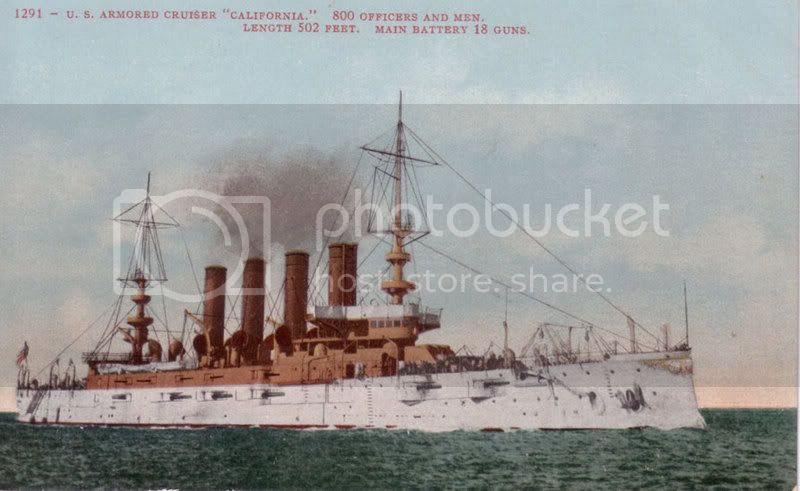
General Statistics
Displacement: 13,680 tons
Length: 504 feet
Beam: 69 ft 6 in feet
Draft: 26 ft 1 in feet
Speed: 22 knots
Complement: 830 officers and men
Armament: 4 x 8 inch guns
14 x 6 inch guns
18 x 3 inch guns
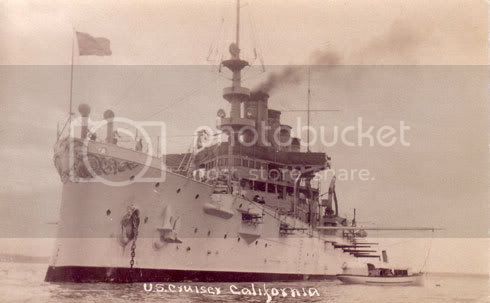
The series on the “Pathfinders” has not been forgotten and we pick up the thread again whilst the Fleet is heading towards Manila.
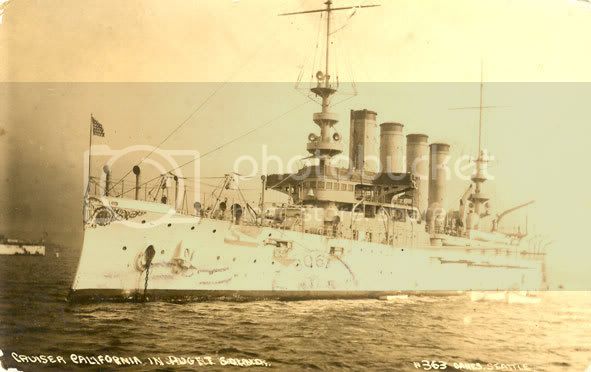
The second USS California (ACR-6), also referred to as "Armored Cruiser 6", and later renamed San Diego, was a United States Navy Pennsylvania-class armored cruiser.
The USS California was launched on the 28th of April 1904 by Union Iron Works, San Francisco, California, sponsored by Miss Florence Pardee (daughter of California Governor George C. Pardee), and commissioned the1st of August 1907, with Captain V. L. Cottman in command.
A picture of the commissioning of the USS California (ACR-6) at Mare Island Navy Yard on the1st of August 1907.
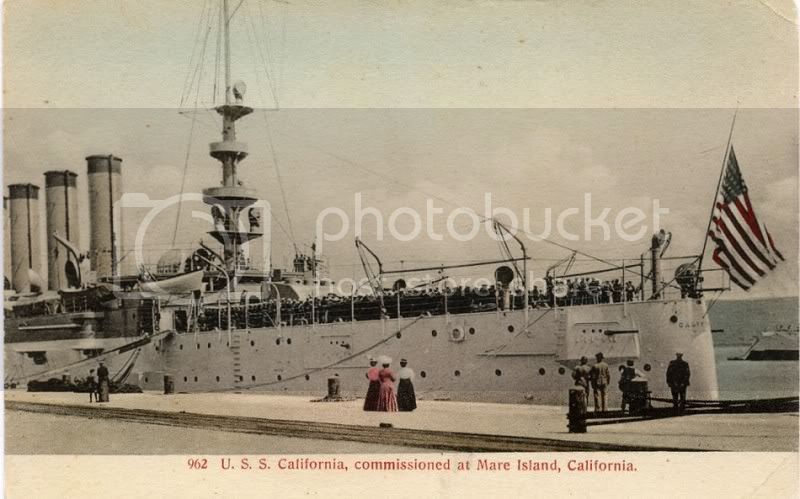
Joining the 2nd Division, Pacific Fleet, USS California took part in the Naval Review at San Francisco in May 1908 for the Secretary of the Navy.
The USS California photographed circa 1908
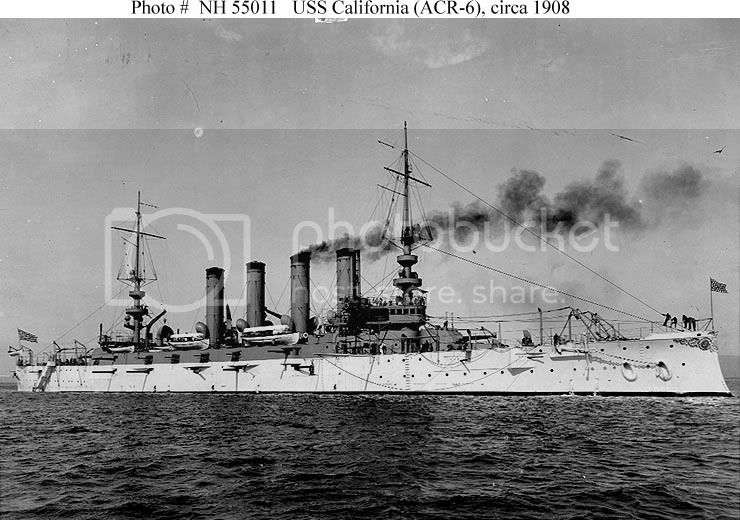
It was at Magdalena Bay on December 28th 1907 that the USS California and the USS South Dakota met the Pathfinders squadron and waited for the Battleship Fleet to join them. Aside from this cruise to Hawaii and Samoa in 1908 fulfilling its duties as part of the Great White Fleets Pathfinder Squadron, the cruiser operated along the West Coast, sharpening her readiness through training exercises and drills, until December 1911, when she sailed for Honolulu, and in March 1912 continued westward for duty on the Asiatic Station.

After this service representing American power and prestige in the Far East, she returned home in August 1912, and was ordered to Corinto, Nicaragua, then embroiled in internal political disturbance. Here she protected American lives and property, then resumed her operations along the West Coast; she cruised off California, and kept a watchful eye on Mexico, at that time also suffering political disturbance.
A picture taken of Guaymas, Mexico on the 26th of December 1915
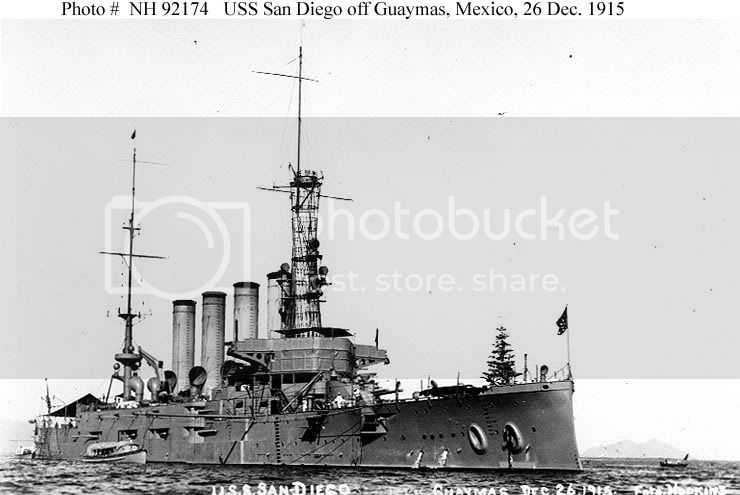
Underway in San Pablo Bay, California 1909
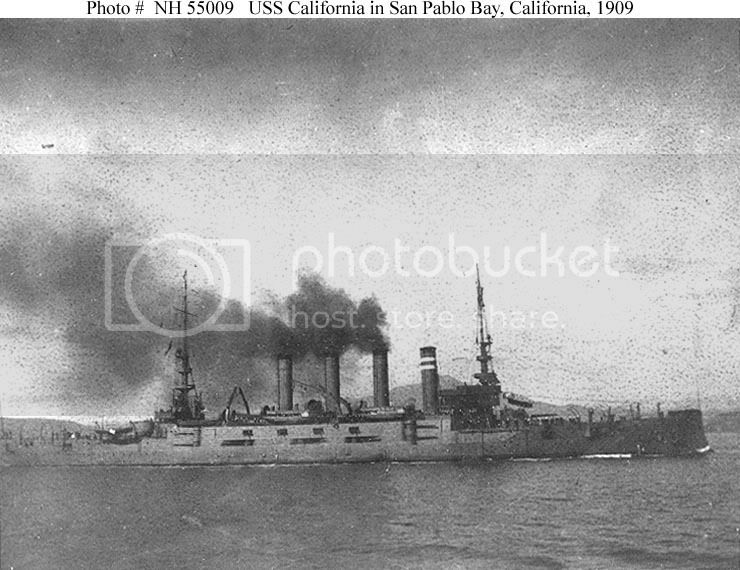
The USS California was renamed San Diego on 1 September 1914, and served as flagship for Commander-in-Chief, Pacific Fleet, intermittently until a boiler explosion put her in Mare Island Navy Yard in reduced commission through the summer of 1915.
A picture on the 28th of January 1915 whilst serving as Flagship of the Pacific Fleet note the two star Rear Admiral’s flag flying from her mainmast top

Photographed from an airplane in San Deigo Harbour, California on the 28th of March 1916

San Diego returned to duty as flagship through 12th of February 1917, when she went into reserve status until the opening of World War I. Placed in full commission the 7th of April 1917, the cruiser operated as flagship for Commander, Patrol Force Pacific Fleet, until the 18th of July 1917, when she was ordered to the U.S. Atlantic Fleet.
Admiral William B. Caperton, USN, Commander-in-Chief, U.S. Pacific Fleet (center) with members of his staff on board USS San Diego (ACR-6) at San Diego, California, circa 1916-17. The ship's after eight-inch gun turret is behind them. Those present are (from left to right) Lieutenant (Junior Grade) H.M. Lammers, USN,Captain R.M. Cutts, USMC, Medical Inspector E.S. Bogert, USN, Admiral Caperton, Pay Inspector J. Fyffe, USN, Lieutenant A.T. Beauregard, USN, and Paymaster C.S. Baker, USN.

Reaching Hampton Roads on the 4th of August, 1917 she joined Cruiser Division 2, and later bore the flag of Commander, Cruiser Force, Atlantic, which she flew until the 19th of September 1917.
A picture of the USS California in San Deigo Harbour, California circa 1910-1914.
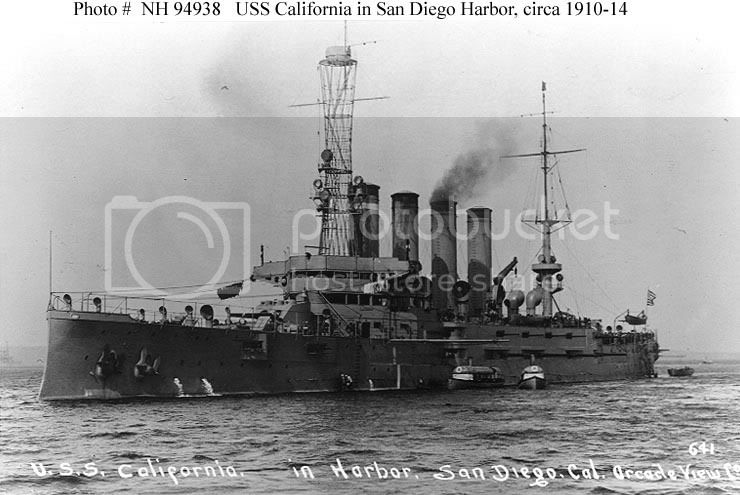
San Diego's essential mission was the escort of convoys through the first dangerous leg of their passages to Europe. Based in Tompkinsville, New York, and Halifax, Nova Scotia , she operated in the weather-torn, submarine-infested North Atlantic safely convoying all of her charges to the ocean escort. On the 19th of July 1918, bound from Portsmouth, New Hampshire, to New York, while ten miles southeast of Fire Island San Diego suffered an explosion and sank within 28 minutes with the loss of six lives, the only major warship lost by the United States in World War I. Her commanding officer, Harley H. Christy, survived the wreck.
The Navy initially declared that she had been torpedoed by the German submarine U-156. Later historians believe that it was sunk by a mine laid by a U-boat. However, U-156 carried no mines, and the blast hole is remarkably far toward the cruiser's stern -- an unlikely place to strike a mine.
Other possibilities include a fire caused by spontaneous combustion in the coal bunkers could have ignited ammunition stored nearby, and sabotage by a German agent, a theory raised by the release of secret Russian documents that asserted a spy planted a bomb aboard.
The wreck presently lies in 33 m (110 ft) of water, with the highest parts just 20 m (65 ft) below the surface, and as a result is one of the most popular shipwrecks in the US for scuba diving. Nicknamed the "Lobster Hotel" for the abundance of lobsters living there, it is also a home to many kinds of fish. The wreck is listed in the National Register of Historic Places.
Cheers
Sean









